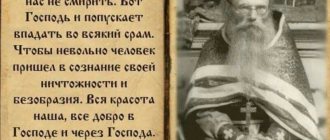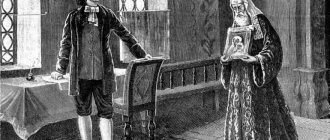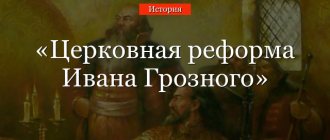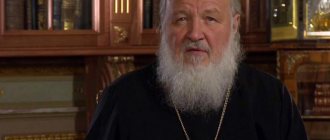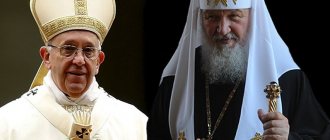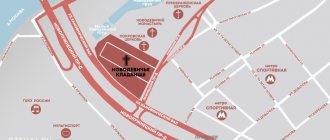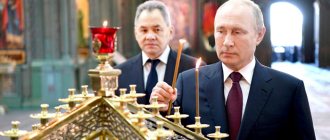- October 3, 2019
- Personalities
- Olga Alekseeva
The sixth patriarch of Rus', close to Tsar Alexei Mikhailovich, Nikon was the brightest figure of his time. He is the author of the church reform carried out in the 17th century, after which a schism arose in Orthodoxy and the Old Believers appeared. Where Patriarch Nikon is buried is still of interest not only to historians, but also to ordinary parishioners.
Nikon's personality
The future patriarch was born in 1605 in Nizhny Novgorod district. His name was Nikita Minov, he came from a peasant family. At the age of 20 he began to serve as a priest, and at 30 he took monastic vows.
Being charismatic and energetic, he managed to make a brilliant church career and was elected patriarch. The government entrusted him with carrying out a liturgical reform aimed at unifying books and rituals according to Greek models. The changes met significant resistance among the clergy, and a church split occurred. Nikon's supporters were called Nikonians, and his opponents - Old Believers.
Nikon’s authorship belongs to the thesis “The priesthood is higher than the kingdom,” which ultimately led to the patriarch’s break with Tsar Alexei. The priest retired to the New Jerusalem Monastery near Moscow, which suited the sovereign quite well. At the church council of 1666-1667. Nikon was deprived of the rank of patriarch and sent to the Ferapontov Monastery.
Under which king was Patriarch Nikon pardoned? This happened in 1681. The new sovereign Theodore Alekseevich had mercy on the former patriarch and allowed him to return to the New Jerusalem Monastery. But on the way, Nikon, the former patriarch of the Russian Church, died.
Biographical information
Patriarch Nikon was born into a family of ordinary peasants on May 7, 1605 in a small village called Veldemanovo. Already at the age of 12, the future head of the Orthodox Church left his father’s house, beginning his studies in a monastery.
At the age of 20, Nikita Minich (the secular name of the patriarch) moved to Moscow. Minin's family had to endure several tragic events.
The three children he had during his marriage died soon after. That is why Nikita Minich subsequently took monastic vows.
While on the Solovetsky Islands, in 1643 Nikon received the rank of abbot. 3 years after this, he moved to Moscow due to collecting alms for the church.
In the capital, he met Alexei Mikhailovich, who became the main figure in the life of the future head of Russian Orthodoxy. It was the sovereign who granted Nikon the rank of archimandrite of the Novospassky monastery, which was used at that time for the burial of members of the Romanov family.
In 1649, Nikon was elected Metropolitan of the Novgorod Land . A few months after this, he began to experience a rather difficult stage in his life. At this time, famine began in Novgorod, which provoked a riot in the city.
Such tests allowed the clergyman to demonstrate true courage, fortitude and willpower.
In 1652, Russian Patriarch Joseph died. For this reason, the king suggested that Nikon take his position, to which the latter agreed.
What is the essence of the reforms?
Speaking about the changes that took place in the Orthodox Church during the time of Nikon, people usually remember the correction of liturgical texts and the introduction of three fingers instead of two fingers. These are indeed major external changes, but the essence of the reform was much deeper.
In the 17th century, a situation arose in Russia when religious rituals were very different from those that were accepted throughout the world, including in Greece, where Christianity came from. The king drew attention to this discrepancy and invited the clergy to restore order.
The reform implemented by Nikon was expressed as follows:
- The sign of the cross began to be made with three fingers instead of two.
- Bows to the ground were replaced by bows from the waist.
- Corrected church letters.
- The name of God began to be written "Jesus" instead of "Isus".
- The religious procession began to take place counterclockwise.
- Secular power was recognized as supreme - according to the Protestant model.
The church reform of Patriarch Nikon was radical and crossed out everything in church life that had come before it. It was at this time that the term “Orthodoxy” appeared; before it, the concepts of “true believer”, “true faith”, “God’s faith” were used.
White General Grigory Mikhailovich Semenov, Transbaikal Ataman, was hanged in the USSR
Discussion: 13 comments
- Yuri - DV:
08/31/2007 at 00:00There were good intentions, of course. They are more expensive than the lives of the Old Believers, more expensive than the split in the consciousness of the Russian people, more expensive than the subsequent enslavement of the common people, more expensive than the national one, more expensive than the subsequent 17th year. Then the Lord will judge both Alexy 2 and Putin.
- Sinner:
09/06/2008 at 00:00
A MAN OF HOLY LIFE, ETERNAL MEMORY TO HIM!
- Dimitry Taushkanov:
09/01/2010 at 00:00
Truly, God is his judge! But it is somehow bold (to put it mildly) to declare a saint a person who has trampled upon the decree of St. The Council of the Hundred Heads, which filled the sacred texts with many errors, sent thousands of Orthodox Christians to the rack, bonfires and other city executions!
- Dimitry Tashkanov:
09/03/2010 at 00:00
Look, my dear, WHEN the executions of the Old Believers began and WHERE and in what position Nikon was at that time. So don't slander him. And how many Stavroporite believers burned themselves - by suicide...
- Victoria:
10/31/2010 at 00:00
Nikon died on the way to Moscow. The Lord did not allow Judas to set foot on the Holy Russian Land, which he drenched in blood.
- Vadim Vinogradov:
08/07/2013 at 00:00
III Rome (Moscow - Third Rome) is the devil's Trojan horse, brought into Russia by Nikon, who, of course, did not know about all the destruction he was causing to Holy Rus'. Just as there is no understanding of this destruction of the idea of III Rome for Russia, to this day. Precisely because the idea of III Rome is extremely attractive to Russian people. In the 17th century, seduced by Nikon with the idea of making Moscow the religious capital of all Orthodox peoples, Tsar Alexei Mikhailovich caught fire. Well, after all, it is the pinnacle of nobility to turn Moscow into Rome III! What Russian doesn't like driving fast? - this catchphrase of Nikolai Vasilyevich is not about driving the troika itself. It is about one characteristic feature of a Russian person - his prowess. That is, about his not always humble and meek state. It was precisely the Russian prowess that accepted the noblest idea of uniting all Orthodox peoples, with the aim of spreading Orthodoxy throughout the land. But only Russia, as a result of this passionate desire for the guiding idea of Holy Rus', “Faith. Tsar. Fatherland.” - began to gradually take first place, replacing the ideal of Holy Rus' “Kingdom of Heaven” with “Russia, forward!” over three and a half centuries. Precisely, this was the fruit of the actions of the power-hungry, vain, proud Nikon
- MVN to V. Vinogradov:
08/08/2013 at 00:00
Dear Vadim Petrovich, it seems to me that you often get carried away when, out of “good intentions,” you throw out the baby with the bathwater—for example, in articles against culture, or condemning the abolition of crepe. right in this case too. For the concept of the Third Rome can be rejected and condemned only on the basis of a false (non-Orthodox) interpretation of it. My understanding of Rome is different, it is based on patristic teaching, see chap. X in the book VTR, as well as: https://rusidea.org/25052803 and https://rusidea.org/6037 (“On the restoration of the self-awareness of the Third Rome”) I read the article you sent about P. Nikon, I also consider it passionate biased. Are you familiar with the book by M.V. Zyzykina about Nikon? He might He’s not right in everything, but a lot has been said that is correct for understanding his church ideology and his goals.
- Vadim Vinogradov:
08/09/2013 at 00:00
Dear Mikhail Viktorovich, There is a place nearby, at the door - this is the Third Rome, or what? And 1200 pages of capital work by Professor M.V. I read Zyzykin’s “Patriarch Nikon,” which he dedicated to the defense of Nikon. But the truth took its toll. The million authentic documents that Zyzykin cites allow us to conclude that it was Nikon who gave the start in the Russian Orthodox Church to loving the external over the internal and ritual over the spirit, which allowed the Nikonians over 300 years to replace the Body of Christ with an organization that is now in the 21st century under the name of the Moscow Patriarchate, it covers up its service to the world with service, supposedly, to God. And further. Defenders of Nikon neglect the point of view of the Old Believers on his actions. Is it right not to pay attention to the grandiose phenomenon of Russianness - the Old Believers? Yes, Old Believers do not interfere with the TV screen. But the Lord revealed their spiritual beauty to the world through the “Taiga Dead End”! And the world, no longer capable of Christian feats, admired them and immediately didn’t give a damn about them.
- R.A.S.:
08/30/2016 at 00:00
4th paragraph below error cathedral code 1649
- Administrator:
08/30/2016 at 00:00
Thanks for correcting the typo.
- Zofia:
08/30/2018 at 21:22
“... asked the deceased for permission letters from four Eastern patriarchs, restoring Nikon to patriarchal dignity,” - everything is bought, everything is sold. Whatever you want, there is a price for everything: if you want, we will overthrow it, if you want, we will restore it. He who pays calls the tune. In this case, the king, the Anointed of God (father and son) juggled the eastern patriarchs as they wanted for a bribe.
- From the taiga wilderness:
08/31/2018 at 16:01
From Vinogradov: -...But the Lord revealed their (Old Believers) spiritual beauty to the world through the “Taiga Dead End”!..
ANSWER. -Smiled. Vinogradov might make a joke closer to midnight... That’s what it is - external, my dear. He exposed himself. MA-LAD-TSA, Grapes.
- Igor:
08/31/2019 at 19:45
And here is what I. Bryanchaninov and T. Zadonsky write about the results of the Nikon reform in the 18th - 19th century I. Bryanchaninov-Otechnik-Conclusion
These tales depict ancient monasticism as if in a painting. The elders-narrators depicted with simplicity and fidelity both the amazing spiritual perfection of monasticism in the first centuries of Christianity, and the various passions of many of its members for the weakness of nature, corrupted by the fall. And despite the fidelity combined with the simplicity that distinguishes this painting, the position of ancient monasticism, being separated from us by the space of many centuries, remains discontentedly clear, like a building separated from view by thick fog.
From the spectacle presented by antiquity, let us turn to the spectacle presented by modernity. What should we say about ourselves? how to live, how to act? We find the answer to these questions from the ancient monks: they foreshadowed our situation; They predetermined the way of action in this situation. “In the last time,” said one of them, those who will truly work for God will wisely hide themselves from people and will not perform signs and wonders in the midst of them, as at the present time. They will follow the path of action, dissolved in humility, and in the Kingdom of Heaven they will turn out to be greater than the Fathers, glorified by signs”[1649]. What profound instruction, what consolation for us in these prophetic words of the sign-bearing and spirit-bearing Father! Due to the multiplication of temptations, due to their universality and dominance, due to the forgetting of the Gospel commandments and their neglect by all humanity, it is necessary for those who wish to be saved to withdraw from human society into external and internal solitude. Due to the drying up of grace-filled leaders, due to the multiplication of false teachers, deceived by demonic delusion and dragging the whole world into this deception, it is necessary to live dissolved in humility, the most precise living according to the Gospel commandments is necessary, it is necessary to combine prayer with crying for oneself and for all humanity, caution is necessary against any passion for passion, thinking of doing God’s work with human forces alone, without God acting and doing His work. Let the one who saves save his soul, it is said to the remnant of Christians, it is said by the Spirit of God. Save yourself! blessed if you find one faithful collaborator in the work of salvation: this is a great and rare gift of God in our time. Beware, if you want to save your neighbor, that he does not drag you into a pernicious abyss. The latter happens hourly. The retreat was allowed by God: do not try to stop it with your weak hand. Stay away, protect yourself from him: and that’s enough for you. Get acquainted with the spirit of the time, study it, so as to avoid its influence if possible. “Nowadays there is almost no true piety (Orthodoxy), says Tikhon of Zadonsky in 1750: now there is only hypocrisy.” Fear hypocrisy, first in yourself, then in others: fear precisely because it is in the nature of the times and is capable of infecting anyone at the slightest deviation into frivolous behavior. Do not strive for show to people, but in secret for your salvation, in the eyes of God, and your behavior will be cleansed of hypocrisy. Do not condemn your neighbors, leaving judgment over them to God, and your heart will be cleansed of hypocrisy. Pursue hypocrisy within yourself, driving it out of yourself; Avoid the masses infected by it, acting both intentionally and unconsciously in its direction, covering up service to the world with service to God, seeking temporary blessings with seeking eternal blessings, covering with the guise of holiness a corrupt life and a soul completely devoted to passions.
Society's reaction
Nikon's changes were met with massive popular uprisings. Some were dissatisfied with the reforms and openly expressed their opinions, others simply left the country, not wanting to submit to heresy.
The Patriarch ordered the books to be burned. But people were also burned at the stake. Nikon was cruel and implacable. In fact, the state organized an inquisition and dealt with those who did not want to accept the new order.
The importance of reforms
Through the reforms carried out, the patriarch achieved the destruction of the ancient religion of Rus' and brought all church orders into line with international ones. As a result, Russian Christianity began to resemble Greek and Roman.
Some historians believe that Nikon, by destroying all ancient books, thereby eradicated the spirit of primitive Christianity in Rus'. Others are of the opinion that the patriarch, on the contrary, carried out a return to the original Greek version of the religion. In any case, one cannot ignore the fact that after the destruction of many religious books, Rus' lost a huge layer of its cultural heritage.
RESULTS OF ACTIVITY
- Nikon's activities contributed to the strengthening of royal power
- Church reform strengthened the centralization of the church and brought it into unification
- The church reform caused anger and mass protests. The protest of the monks in the Solovetsky Monastery in 1668-1676 was especially strong. Only with the help of the tsarist troops was it possible to suppress the uprising.
- The beginning of the church schism is associated with the name of Nikon; there are representatives of the Old Believers in Rus' today, they believe that Nikon has encroached on the foundations of the church.
How did the fate of the patriarch turn out?
At the council of 1666, Nikon was deprived of the patriarchate due to claims to supremacy in secular power. He was exiled to the Ferapontov Monastery, and 10 years later to Kirillo-Belozersky. Nikon's exile lasted 15 years.
Before his death, Tsar Alexei Mikhailovich asked the patriarch for forgiveness. Feodor Alekseevich, having reigned, decided to return Nikon to the rank and allowed him to return to the Resurrection Monastery.
Having set off on the journey, the patriarch died in 1681. In 1682, all four Eastern Patriarchs sent letters to Moscow restoring Nikon the rank of Patriarch of All Rus'.
Patriarchal activities
In the 17th century, the role of the patriarch was one of the key in the state. His functions included making very important decisions for the country. These included pardoning innocently convicted people, holding consultations with the king about his actions, as well as conducting trials arising on certain spiritual issues.
As a result, Alexey Mikhailovich constantly expressed his trust and respect to Nikon. In fact, the patriarch became co-ruler of the Moscow state.
Nikon not only led the church, but also often influenced a large number of secular affairs. It was he who in 1654 was one of the initiators of the reunification of Ukraine with Russia. The territories of Rus', which at that time were part of the Grand Duchy of Lithuania, became subordinate to Moscow.
Thus, the Russian Church was able to return the Orthodox dioceses belonging to South-Western Russia that had previously separated from it. After some time, a similar process occurred with those parishes that were located on the territory of modern Belarus.
Patriarch Nikon went down in history thanks to his following achievements:
- intensifying church construction throughout the state;
- unification of ritual traditions with Greek norms;
- restoration of Ukraine with Russia, etc.
During Nikon's reign, some of the largest and richest Orthodox monasteries . Many monasteries in the state were founded in the 17th century.
Where is Patriarch Nikon buried?
This question arose before the society in October 2013, when, after archaeological excavations on the territory of the New Jerusalem Monastery, it turned out that the patriarch’s tomb was empty. The church authorities reacted to the news rather restrainedly. Patriarch Kirill expressed regret that historians disturbed Nikon’s tomb.
The monastery restorers asked for a blessing to open Nikon’s burial place back in 2009. Believers were awaiting this event in order to canonize the saint. The presence of incorruptible relics would lead to the success of such an event. But the patriarch did not give permission to open the tomb. This led the laity to believe that the church knew something about Nikon’s remains that was not disclosed to ordinary parishioners.
Experts believe that Patriarch Nikon of the Russian Orthodox Church is buried elsewhere. The grave in the New Jerusalem monastery was only a deception to mislead the enemies of the priest. Archaeologists opened the tomb, despite the discontent of the church authorities, and found it empty.
Nikon (Patriarch of Moscow)
Alexei Mikhailovich and Nikon in front of the tomb of St. Philip.
A. D. Litovchenko, 1886 April 15 (25), 1652, on Maundy Thursday, Patriarch Joseph died. The “zealots” offered the rank of patriarch to Stefan Vonifatiev, but he refused, apparently understanding who Alexey Mikhailovich wanted to see on the patriarchal throne.
At the beginning of July 1652, the relics of the holy Metropolitan Philip were delivered to Moscow from the Solovetsky Monastery - the initiator of the transfer of the relics to the capital was Metropolitan Nikon of Novgorod, who received an offer from Tsar Alexei Mikhailovich to replace the patriarchal throne in front of the tomb of the saint.
On July 25 (August 4), 1652, Nikon was solemnly enthroned as the Patriarchs of Moscow and All-Russia. During his enthronement, Nikon forced the tsar to promise not to interfere in the affairs of the Church. The king and the people swore to “listen to him in everything, as a ruler and a shepherd and a noble father”[14].
Reform activities
Main article: Schism of the Russian Church
See also: Old Believers
Church Council of 1654
(Patriarch Nikon presents new liturgical texts) A. D. Kivshenko, 1880
Having collected Greek and Byzantine texts for many years and seriously participated in discussions of the “Circle of Zealots of Piety” (which also included Archpriest Avvakum), Nikon considered it important to bring Russian Orthodox rites and books into line with Greek ones.
Before Lent in 1653, Nikon prescribed making the sign of the cross with three fingers, which contradicted the acts of the Local Council of the Hundred Heads of 1551, which established two fingers. Nikon then continued the reform, collecting cathedrals. The Council of 1654 marked the beginning of the unification of Moscow books according to Greek books printed in the 16th century in the West. And if the definitions of this Council were considered and agreed upon at the Council of Constantinople of the same year under the chairmanship of Patriarch Paisius, then the decision of the local Moscow Council of 1656, at which everyone who crossed themselves with two fingers was declared heretics and anathematized, contradicted it [comm. 2]. The hasty anathema of the council of 1656 on all those who cross themselves with two fingers, which was subsequently canceled by the Local Council of the Russian Orthodox Church in 1971, became the main cause of the Schism of the 17th century.
The rootedness both among the people and among a significant part of the clergy of the opinion about the “superiority” of Russian piety over Greek, and Moscow - over Kiev, which appeared in North-Eastern Rus' after the Greeks signed the Union of Florence with Catholics, the fall of Constantinople, the Polishization of Lithuania and the conquest of Lithuania Kiev (cf. the thesis “Moscow is the Third Rome”), as well as the harshness of the reformers themselves, led to a split in the Russian Church into supporters of Nikon (“Nikonians”) and his opponents, the Old Believers, one of whose leaders was Avvakum.
Construction
Valdai Iversky Monastery, founded by Nikon
One of the areas of activity of Patriarch Nikon was the founding of monasteries in Russia. In 1653, the first wooden buildings of the Iversky Monastery were built on the island of Lake Valdai. In 1655, the stone Assumption Cathedral was laid.
In 1656, Nikon obtained permission from the Tsar to found a monastery on Kiy Island, now known as the Onega Cross Monastery. The construction of the first structures on the island from 1656 to 1659 was led by the elders Nifont Terebinsky and Isaiah, as well as the steward Vasily Paramonovich Poskochin - Nikon’s confidants. In the same 1656, Patriarch Nikon founded the New Jerusalem Monastery as the residence of the patriarchs near Moscow. The monastery was built on the lands of the village of Voskresensky. According to Nikon's plan, in the future it was to become the center of the Orthodox world.
Disagreement with the king
New Jerusalem Monastery, founded by Patriarch Nikon in 1656.
The young Tsar Alexei Mikhailovich revered Patriarch Nikon, trusted his advice in matters of government, and during the wars with the Polish-Lithuanian Commonwealth (1654-1667) and his long absence, he left the patriarch de facto at the head of the government. By order of the tsar, the royal title “Great Sovereign” was added to the title of the patriarch “Great Master”[15]. This situation aroused envy and discontent both from the boyars, who did not want to lose the opportunity to influence the tsar in their own interests, and from many clergy, in particular, former members of the circle of “zealots of piety.”
Patriarch Nikon sought to counter what he perceived as an encroachment by the civil government on its jurisdiction and powers. Particular protest was caused by the adoption of the Council Code of 1649, which belittled the status of the clergy, placing the Church virtually subordinate to the state.[16] Thus, income from the exploitation of monastic estates passed to the Monastic Order created within the framework of the Code and entered the state treasury; secular courts began to consider cases that fell under the jurisdiction of church courts.
As a result of this, as well as intrigues on the part of some of the boyars and clergy who had influence on the tsar and were hostile to Patriarch Nikon, there was a cooling of relations between the tsar and the patriarch. On July 10 (20), 1658, Nikon left Moscow as a protest: without giving up the Moscow See, he retired to the Resurrection New Jerusalem Monastery, which (along with the Cross and Iversky Monasteries) he himself founded in 1656 and had as his personal property[17] .
However, the reason for the quarrel between the patriarch and Alexei Mikhailovich, in addition to the steps taken by the latter, was the philosophical activity of Nikon himself. Having enjoyed the respect of the tsar in his early years, when he even called Nikon “the great sovereign,” the patriarch developed a concept according to which he put forward the thesis “the priesthood is higher than the kingdom,” based on the fact that not a single secular law can be higher than the church, divine [18 ].
Disgrace and ejection from the priesthood
See also: Great Moscow Cathedral
The trial of Patriarch Nikon (S. D. Miloradovich, 1885)
In 1660, at a Council convened in Moscow, it was decided to deprive Nikon of the bishopric and even the priesthood; however, the trial did not take place, since it was decided to transfer the case to the court of the Eastern Patriarchs, on the advice of Nikon’s monk-inquirer Epiphanius Slavinetsky and Archimandrite of the Polotsk Epiphany Monastery Ignatius Ievlevich. The same solution to the issue was subsequently recommended to the king by the former bishop of the Jerusalem Church, Paisius Ligarid [comm. 3], who did not take an obvious part in the Council, although he was invited by the patriarchs to a secret meeting and acted as a translator for the Eastern patriarchs.
The patriarchs, invited back in 1662, did not find it possible to come to Moscow for a long time. Finally, in November 1666, a local cathedral of the Russian Church opened - the Great Moscow Cathedral with the participation of two patriarchs: Paisius of Alexandria and Macarius of Antioch. Both patriarchs at that time were considered in Constantinople to have been deprived of their chairs by the decision of the Council in Constantinople (they were charged with a long absence from their patriarchates, which occurred due to the request of the Russian Tsar Alexei Mikhailovich to visit Russia and take part in the Great Moscow Council), but in Moscow We received news of this after Nikon’s trial. In addition, later, at the request of the Russian Tsar, the Patriarch of Constantinople canceled his decisions to deprive the chairs of the Patriarchs of Alexandria and Antioch.
The ideological basis and documents of the Councils of 1666-1667, the most important subject of consideration of which was the final discussion of the “Nikonian” liturgical reforms, unacceptable for supporters of the “old faith,” were developed by the learned monk of the “Latin” persuasion Simeon of Polotsk, Paisius Ligarid and the archimandrite of the Athos Iveron Monastery Dionysius, who lived in Moscow from 1655 to 1669.
On December 12 (22), 1666, the third and final meeting of the Council on the Nikon case took place in the Annunciation Church of the Chudov Monastery.
The letter signed by all the bishops of the Russian Local Church of the Great Moscow Cathedral, as well as the hierarchs (patriarchs, metropolitans, archbishops, bishops) of the Greek local churches dated December 12, indicates the crimes because of which Nikon was expelled from the patriarchate and priesthood by the court of the local council of the Russian Church :
1. Nikon annoyed (offended) the king when he left his flock and retired to the Resurrection Monastery, only because the royal official hit the patriarch’s servant.
2. Nikon did not humble himself and did not repent, but performed consecrations in a new place, built new monasteries, which he called “inappropriate words and vain names”: New Jerusalem, Golgotha, Bethlehem, Jordan, thereby he cursed the divine and mocked the saints, glorifying himself as the patriarch of New Jerusalem, kidnapping him by robbery, and if he had the strength, he would have taken away the third part of the kingdom.
3. He anathematized the patriarchs Paisius and Macarius, who came to judge him, calling them Anna and Caiaphas, and he called the royal ambassadors who were sent to him to summon him to trial Pilate and Herod.
4. Nikon wrote personal letters to the patriarchs, in which he wrote about Tsar Alexei, that the tsar was “a Latin wise man, a tormentor and an offender, Jeroboam and Uzziah” and that the Russian Church had fallen into Latin dogmas, most of all blaming Paisius Ligaridas for this.
5. Nikon, without conciliar consideration, personally deprived Bishop Paul of Kolomna of his rank, became furious, pulled off the mantle from Paul, and handed him over to severe plagues and punishments, which is why Paul lost his mind and the poor man died: either he was torn to pieces by wild beasts, or he fell into the river and died.
6. Nikon mercilessly beat his spiritual father for two years and inflicted ulcers on him, after which the patriarchs themselves saw Nikon’s confessor “completely weakened.”
For these crimes, Nikon was expelled from the priesthood: not only from the patriarchal dignity, but from the episcopal rank and became a simple monk.
Monk Nikon, after the cathedral trial and eruption, was exiled to the Ferapontov Belozersky Monastery; after the death of Alexei Mikhailovich, he was transferred under stricter supervision to the Kirillo-Belozersky Monastery.
Doubts regarding the relics
The question of where Patriarch Nikon is buried arose more than once in the 20th century. The ashes of the great patriarch were already disturbed at the beginning of the century. In 1931, the Soviet commission, which fought against obscurantism in that era, decided to open the tomb, which had remained untouched since 1681.
The workers barely managed to remove the top heavy slab from the burial site. When they lifted her and opened the tomb, everyone was filled with amazement. Patriarch of the Russian Church Nikon lay as if alive. Komsomol members took the gold and diamond panagia and sent them to the museum.
What happened to the remains is still unknown. According to rumors, when they began to take off the patriarch’s vestments, everything fell apart. But this version is questionable. After all, the remains, preserved in perfect condition, simply could not crumble.
It is likely that the believers stole the remains and buried them in an unknown place. They could not allow the shrine to be sent to a museum and put on public display. According to Christians, this is an unthinkable sacrilege. The tomb in the New Jerusalem Monastery was covered with a slab and returned to its previous state.
Where is Patriarch Nikon buried? There is no exact answer to this question yet. And scientists have yet to discover this secret.
